POP or Gypsum: Which is the best false ceiling?
False ceiling are secondary ceiling that are suspended from main ceiling. False ceilings are used to conceal excessive wiring and are an efficient way of making your home more aesthetically pleasing and clutter-free. Off late, false ceilings have become an integral part of home constructions. Homeowners are opting for false ceilings as a way of keeping away excess heat, cold, and noise. Whether you opt for a pop or gypsum false ceiling, you’ll realize that they are an undeniably useful element of modern interior design.
These False ceiling or secondary ceilings are either made of POP (Plaster of Paris) or Gypsum plasterboard. But today one will find Gypsum Plasterboard false ceiling being used majorly especially in main cities like Mumbai, Pune, and others. POP false ceiling is used very rarely today though but only in villages and rural areas.
Why??? Let’s have a look at the difference between POP False Ceiling and Gypsum plasterboard False Ceiling.
POP false ceilings are made of POP powder. The POP powder is applied on chicken net that provides mechanical strength. The POP powder is mixed with water onsite and then applied on the mesh that is attached to local metal framing system; there is a high chance of wastage during this process. Once dried (over a month’s time), it creates a POP false ceiling. A POP false ceiling is not only time consuming but also messy, dusty and gives an unpolished feel compared to Gypsum false ceilings.
A Gypsum board false ceiling is made using gypsum plasterboard’s, fixed with screw to metal frame connected to soffit. Gypsum plasterboard’s come in larger sheets that POP sheets and therefore there are fewer joints. The joints are finished using jointing compound. Installing gypsum plasterboard is a faster process that is clean, much more efficient and healthier due to the less residue and dust arising as part of the process. Gypsum plasterboard has more strength as compared to POP. One of the main reason why gypsum boards are used for false ceiling is because of its hydrophobic properties.
Gypsum plasterboard’s false ceiling offers great flexibility in design. Gypsum plasterboard’s versatility make ii the most preferable product for false ceiling. Cost wise there is no much difference in POP sheet and Gypsum plasterboard.
Gypsum v/s POP: What are the differences?
Gypsum boards:
Gypsum is hydrated calcium sulfate and its quality is perfect for long term use. They are available in a prefabricated form, which is manufactured in a factory and assembled on-site. Gypsum is mostly used in rooms that have large area space and require central air conditioning units.
Pros:
- Installing Gypsum false ceilings is easy, and the cleaning process is quite effortless as well.
- The boards provide a seamless look, which means it is attached to your ceiling without too many joints
- Since they are factory produced, the quality and consistency of the products’ finish is maintained
Cons:
- Even though a gypsum false ceiling is quite easy to install, the whole uninstallation process can be quite tedious. If you ever have to repair the ceiling, it would mean breaking the whole thing down.
- It’s just a matter of time before moisture seeps into the false ceiling, it can be through leaky roofs or air conditioning pipes. This can lead to fungal growth or cause the ceilings to lose their shape. To avoid this inconvenience, it’s best if you opt for moisture-resistant boards.
- Gypsum boards cost more than POP
- As time goes on, a gypsum false ceiling may show signs of cracks around the joints. These cracks may appear due to slight movements in the false ceilings that are caused due to ceiling repair, cutting holes for light and fan fixtures, or in places where the ceiling meets the attached walls.
POP ceilings:
Plaster of Paris, also known as POP, ceilings are quite popular because the homeowner can decide on any design they want. It’s usually available in a powder form that is made into a paste and put up on the ceiling. The paste is manipulated in the design that the homeowner chooses, and it’s applied to a chicken mesh so that it stays afloat.
Pros:
- POP is quite durable with minimal wear and tear.
- They can be flexibly applied to corners and be shaped to any design of your liking
- POP is 20 to 40 per cent cheaper than gypsum boards
Cons:
- You need to have skilled and experienced labour to handle POP designs, otherwise, you won’t get the desired outcome.
- There can be wastage, due to excess mixture, and it can leave the site messy as well.
- The POP ceiling can only be installed once it’s perfectly dried.
POP vs Gypsum: The Final Verdict
In most urban cities, Gypsum is the material of choice of false ceilings because the cost has little impact on the consumer. Since the pros outweigh the cons, in terms of finish, installation process, and cleanliness, homeowners are willing to invest in it even though it comes at a higher cost. Also, if the design is tedious or complex, which means if it involves organic forms or multiple layers, gypsum will get the job done most efficiently. The reason homeowners choose gypsum is that it’s time-saving, and it pairs well with other materials like glass and plywood.
Interior designer’s tips
It’s always best to hire an experienced interior designer and follow their suggestions on choosing the best false ceiling, pop or gypsum. Here are some of the popular suggestions that are made by designers, when it comes to false ceilings:
- If you want quality materials on a budget then its best that you select a peripheral ceiling design and use gypsum boards.
- It’s best if you add a false ceiling only in some parts or only around borders to the existing ceilings. This way you can keep the original ceiling, in most places, and it will make your room feel more spacious while introducing a design feature.
- Even if you want to invest in a gypsum false ceiling then ensure that the design scheme includes other materials like plywood and glass, if needed.
Interested in Home Renovation? – Set up an interior design consultation. Contact us Now!
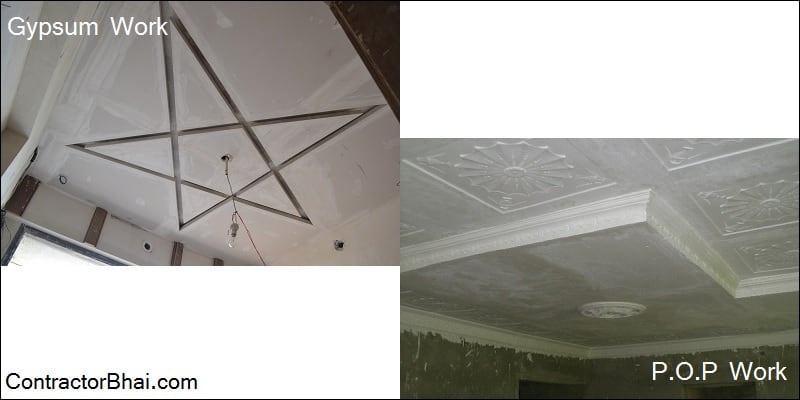
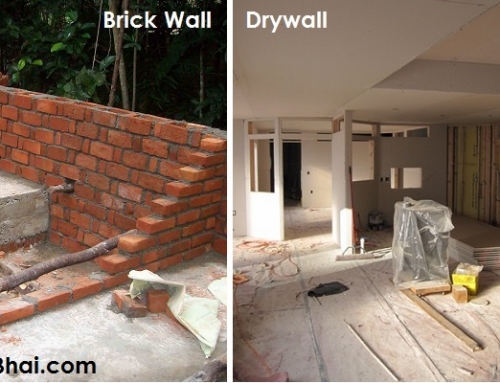
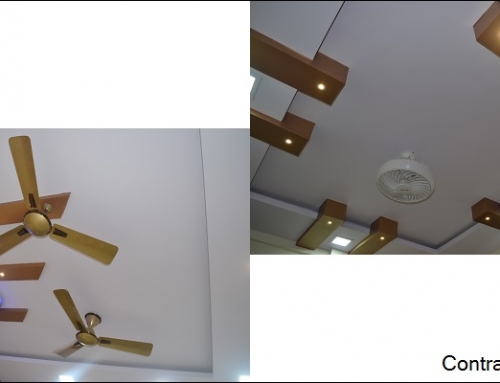
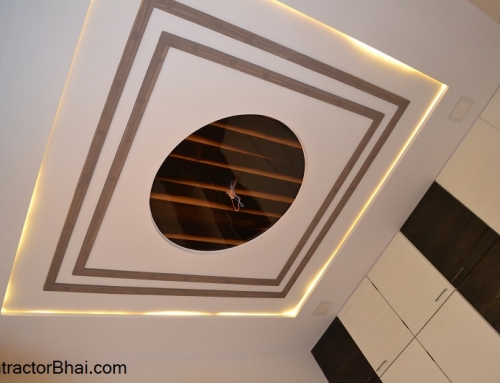
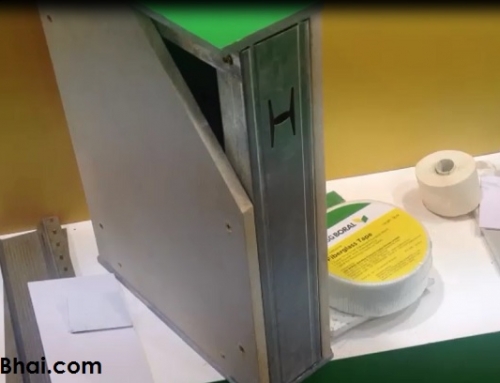
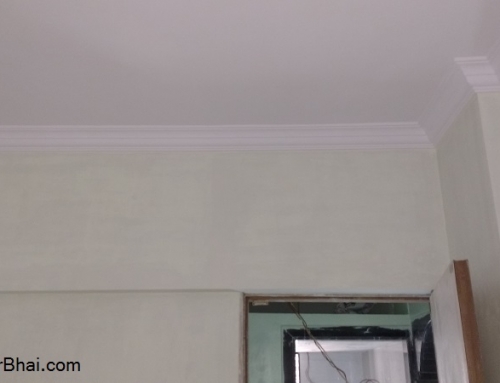
What is the standard height at which false ceiling is to be made?
Helo Nitin bhai, may need your services shorty.
It is very helpful to me.I gather some idea about gypsum & pop.
Can you give me the rate of up down design False Ceiling Appreciate 300Sqft
60 /sqft gypsum ceiling
What gypsum mash used for making a gypsum ceiling
why do you care about mash ? i have never heard of any home owner getting in to so much detail. Is this your house for which you are doing false ceiling.
Do you work in Aurangabad, Maharashtra? Around 300 sq. Ft.
Is the false ceilig made up of Wood also? How is that priced compared to POP/Gypsum?
wood was used to create rafter like design within ceiling. however nowdays due to termite problem and cost of wood, no one uses it. rafter designs are also made using gypsum, or mdf etc.
Can I use plaster cement as joint compound
not recommended. There is gypsum powder made only for same why use cement ?
My contractor is convencing me to go for POP False ceiling. He is telling POP false ceiling is long lasting campare to POP false ceiling. Water seepage will affect Gypsum but not POP. can you please help me …which one shall i select. Gypsum or POP
Gypsum is way to go. Either your Contractor is very old fashioned or he is hiding some agenda.
My vendor recommended me to go for POP False ceiling. He told POP false ceiling is long lasting campared to Gypsum ceiling. Water seepage will affect Gypsum but not POP and also in Villas moisture will be more.. can you please suggest which one shall i select. Gypsum or POP
Gypsum is way to go. Moisture/water should never get in touch with either pop or gypsum. Pop/Gypsum are not meant to resist water.
Gypsum is way to go, not sure why contractor is insisting on POP
Can we install 8mm plywood over gypsum board in false ceiling and put laminate on top of it to make it look better? can we screw 8mm plywood to gypsum board and will it bear the load?
It is done to frame not to gypsum sheet. Please talk to your false ceiling contractor
what is the minimum life of gypsum sealing? in a roof where no seepage is there pls answer
gypsum ceiling if not disturbed, can stay for long long time. I dont see any reason it will go bad
Which company boards are used in Gypsum boards and the best quality along with rates.
My main purpose to install false ceiling is resist heat. Is pop fine for that as I’ve read and heard everywhere that pop ceiling is more durable and they don’t crack though gypsum ceiling also breaks after sometime as they hanged over angles and this happens eventually. My contractor told me this and he said that once pop is installed properly as they do it with jute here then it don’t break or open. Is that right. I am confused whicj one to decide. Pls help
Haseeb ji, go ahead with either option. Both are good option. POP is old fashion way of doing false ceiling. Gypsum sheet are new way of doing ceiling. Both have their own quality. Modern homes have less curvatures and flowery designs. In such scenario Gypsum makes your work fast. Point about strength does not apply because you will never touch false ceiling. Once ceiling is done, no one really touches ceiling on day to day basis. So it never gets damaged.
very good information, thank you so much.